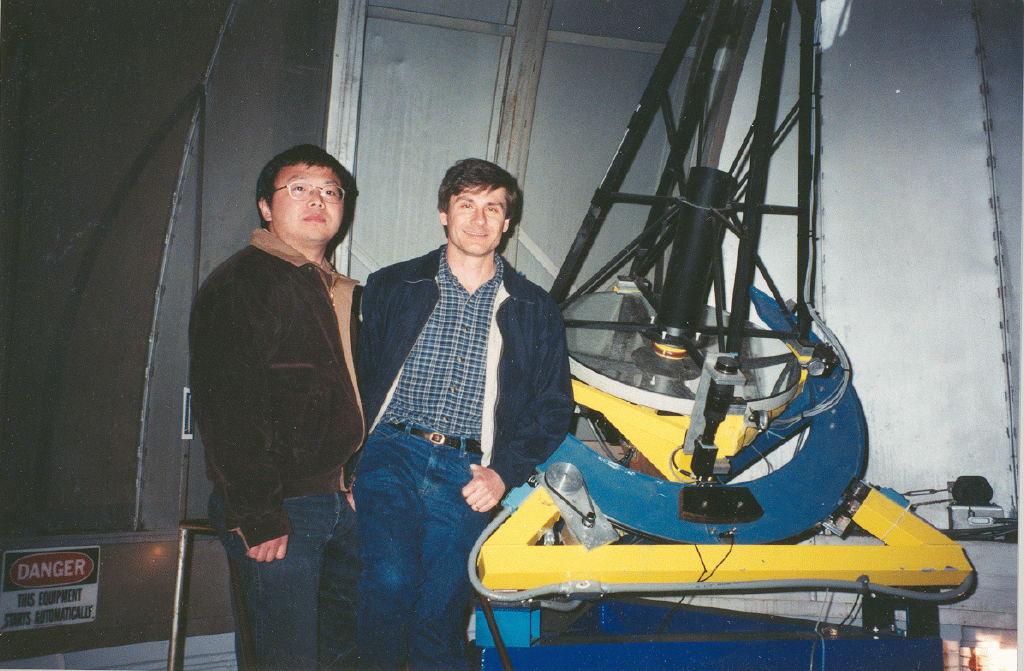
 Copyright © Michael Richmond.
This work is licensed under a Creative Commons License.
Copyright © Michael Richmond.
This work is licensed under a Creative Commons License.
On the night of July 26/27, 2013, I was working at the RIT Observatory, taking images of the cataclysmic variable star UZ Boo. As I was waiting for the CCD to cool, I checked my E-mail and found this item from Patrick Schmeer, a German amateur astronomer who keeps a very close watch on the sky.
[vsnet-alert 16056] Magnitude 12.4 Supernova in M74?
Sent: Friday, July 26, 2013 7:33 PM
To: vsnet-alert@ooruri.kusastro.kyoto-u.ac.jp; cvnet-outburst@yahoogroups.com;
baavss-alert@yahoogroups.com
PSN J01364816+1545310: a possible mag 12.4 supernova in M74
http://www.cbat.eps.harvard.edu/unconf/followups/J01364816+1545310.html
Clear skies,
Patrick
Somewhat cryptic, right? The abbreviation PSN stands for Possible SuperNova, referring to a list of objects kept at the IAU's "Transient Objects Confirmation Page". That page provides a position and rough indication of brightness. In this case, the source of the information was the Lick Observatory Supernova Search (LOSS). LOSS is based on observations made by a 30-inch automated telescope at the Lick Observatory, near San Francisco. The picture below shows the telescope with LOSS team leader Alex Filippenko and post-doc Weidong Li.

A new supernova in a nearby galaxy? Oh, boy! I checked to see when the galaxy would rise: at about 1:30 AM, it would reach 20 degrees above the eastern horizon, which meant it might just clear a big pine tree. Note that the nearly full Moon is only about 24 degrees away -- ugh.
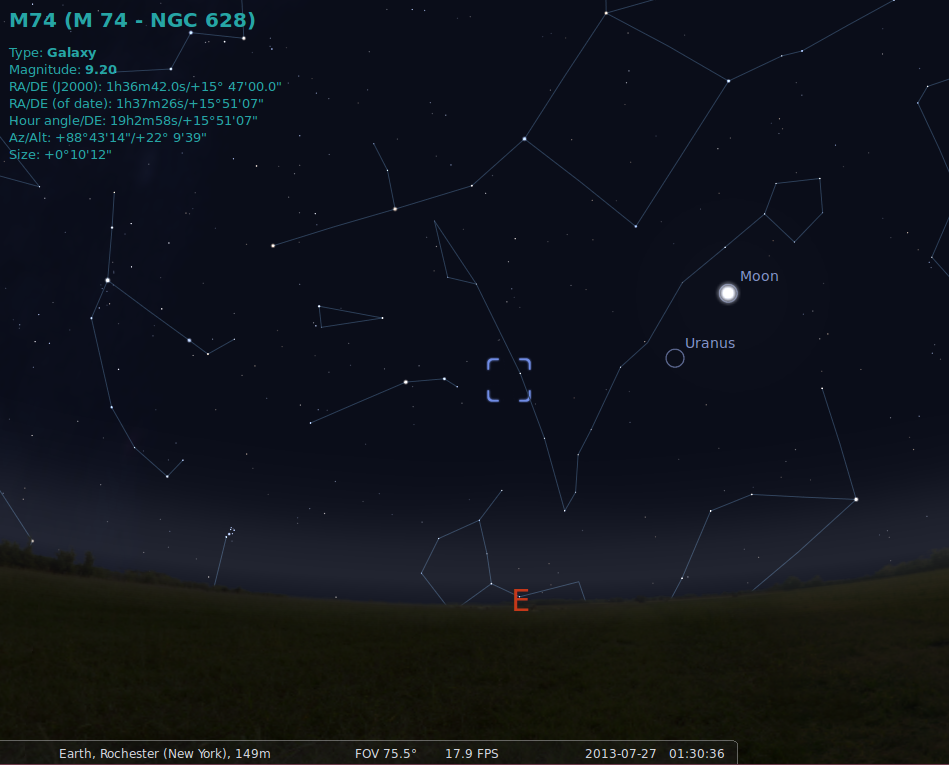
So, I monitored UZ Boo early in the evening, then turned the telescope to M74 around 12:30 AM. The combination of low altitude and nearby moon meant that the background sky was very bright, and I was unable to acquire any guide stars. I took a series of 30-second images through the standard astronomical BVRI filters, some of which turned out better than others. The picture on the left isn't bad, but something is wrong with the picture on the right.

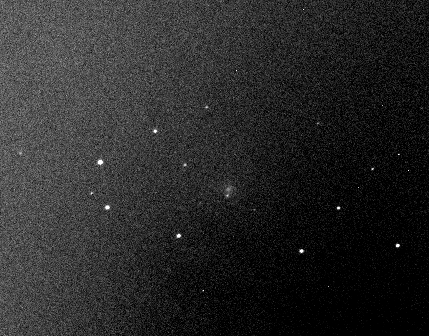
Q: What happened to the picture on the right?
In any case, by 2 AM I had a set of images of the galaxy. Now, was there really a new object in this region of the sky? And, if so, was it really a supernova? See for yourself: on the left is an image of M74 from the Digitized Sky Survey, and on the right, one of my R-band images.
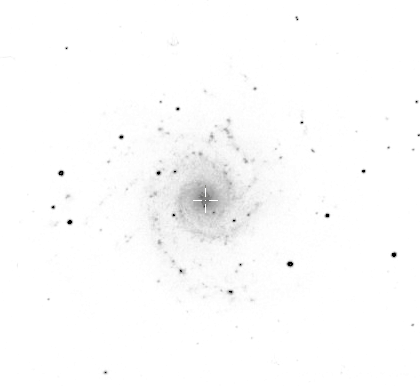
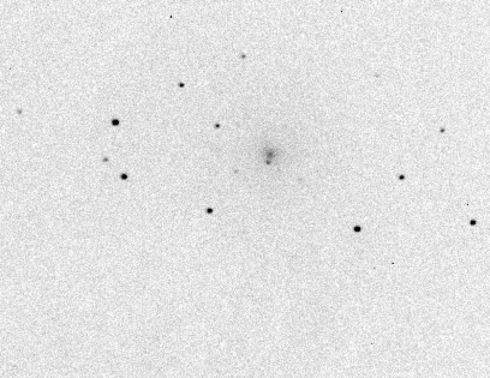
Q: Is there a new object in the galaxy?
If yes, where is it?
Yes, indeed, there was a new object in M74, and at the position reported by the LOSS team. So, not an asteroid -- maybe a supernova!
Now, if this were a young supernova, it would be very hot. That would mean that the light emitted by the object ought to be blue.
Was the light from the new object blue? Well, one relatively easy way to check is to compare the brightness of the new object against the brightness of ordinary stars; most stars tend to be yellow or red, rather than blue.
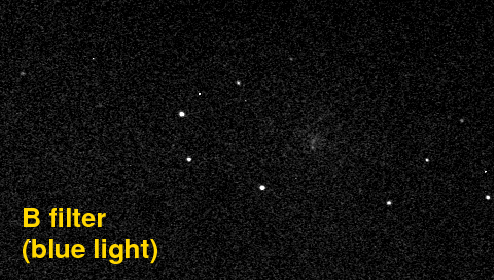
Q: Is the new object BLUER THAN other stars?
REDDER THAN
SIMILAR TO
Q: Do you notice any other stars with strong colors?
I concluded that
So, I sent an E-mail to the IAU Central Bureau for Astronomical Telegrams with the information. I wasn't the only one paying attention that night, as the next morning's IAUC Circular 3606 makes clear:
SUPERNOVA 2013ej IN M74 = PSN J01364816+1545310
Further to CBET 3588, M. Kim, W. Zheng, W. Li, and A. V. Filippenko,
University of California at Berkeley; and S. B. Cenko, Goddard Space Flight
Center, report the LOSS discovery of an apparent supernova in M74 = NGC 628
on unfiltered KAIT images:
SN 2013 UT R.A. (2000.0) Decl. Mag. Offset
2013ej July 25.45 1 36 48.16 +15 45 31.0 13.5 92".5 E, 135" S
The object was observed again on July 26.44 UT at mag 13.1, having increased
about 0.4 mag in one day, indicating that it may be a young supernova on the
rise. No other KAIT observations were made in the past several months,
prior to July 25. A finding chart is posted at the following website URL:
http://astro.berkeley.edu/~zwk/findingchart/PSN_J01364816+1545310.jpg. The
variable was designated PSN J01364816+1545310 when it was posted at the
Central Bureau's TOCP webpage and is here designated SN 2013ej based on the
spectroscopic confirmation reported below. M. W. Richmond, Rochester
Institute of Technology, confirms the presence of a bright new transient in
M74 at the above position; CCD images taken with the RIT Observatory's 30-cm
Schmidt-Cassegrain telescope (+ SBIG ST-8E camera with Bessell filters)
around July 27.21 indicate that the variable is very blue. Additional
magnitudes for 2013ej, via unfiltered CCD unless noted otherwise: July
27.377, 12.8 (A. Amorim, Florianopolis, Brazil, 0.20-m reflector in moonlight;
visual); 27.7, V = 12.6, R = 13.0 (Ernesto Guido and Nick Howes, remotely
using a 0.43-m f/6.8 astrograph of the ITelescope network at Siding Spring;
position end figures 48s.20, 31".0; UCAC-3 catalogue reference stars; an
animation showing a comparison between their confirmation image and a red
Digitized Sky Survey plate form 1996 is posted at URL http://bit.ly/1bvi1OS;
their annotated confirmation image is posted at http://bit.ly/177HYw5);
28.028, 12.8 (Gianluca Masi and Francesca Nocentini, remotely using a 35-cm
robotic telescope at Ceccano, Italy; position end figures 48s.18, 30".9);
28.7, 12.8 (Andrea Mantero, Bernezzo Observatory, Italy; 0.25-m f/4 reflector;
position end figures 48s.01, 31".0; UCAC-4 catalogue reference stars; image
posted at URL http://www.flickr.com/photos/andreagalaxy/9382629530/).
M74 is a nearby spiral galaxy, only about 30 million light years away.
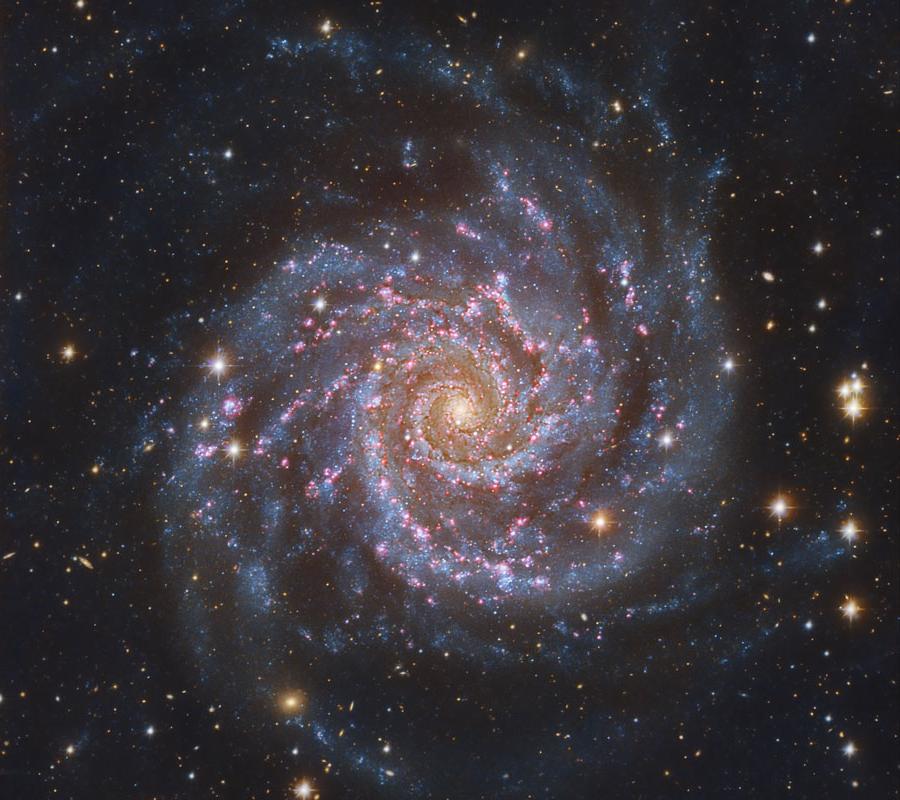
Image thanks to
Descubre Foundation, Calar Alto Observatory, OAUV, DSA, V. Peris (OAUV), J. L. Lamadrid (CEFCA), J. Harvey (SSRO), S. Mazlin (SSRO), I. Rodriguez (PTeam), O. L. (PTeam), J. Conejero (PixInsight).
See the APOD page for
links to these people and groups.
Because the galaxy is so close to our Milky Way, there's a chance that the progenitor of the supernova might have been visible before the explosion. Spectra of this supernova -- SN 2013ej -- showed that it is a Type IIP: the explosion of a red supergiant star with a massive envelope of hydrogen. Red giants are pretty luminous; are they bright enough to be seen at the distance of M74?
A typical red supergiant has absolute magnitude MV = -4
The distance modulus to M74 is roughly (m - M) = 29.8
Q: What might we expect the apparent V-band magnitude of
a red giant in M74 to be?
Q: Could we detect such a star?
That's pretty darn faint. Although M74 is a pretty galaxy, and lots of people take pictures of it, only a few telescopes on (or off) Earth could detect an object as faint as the expected progenitor. On July 28, I started to look into this possibility. The best instrument for this job is the Hubble Space Telescope, so I went to the MAST archive search page.
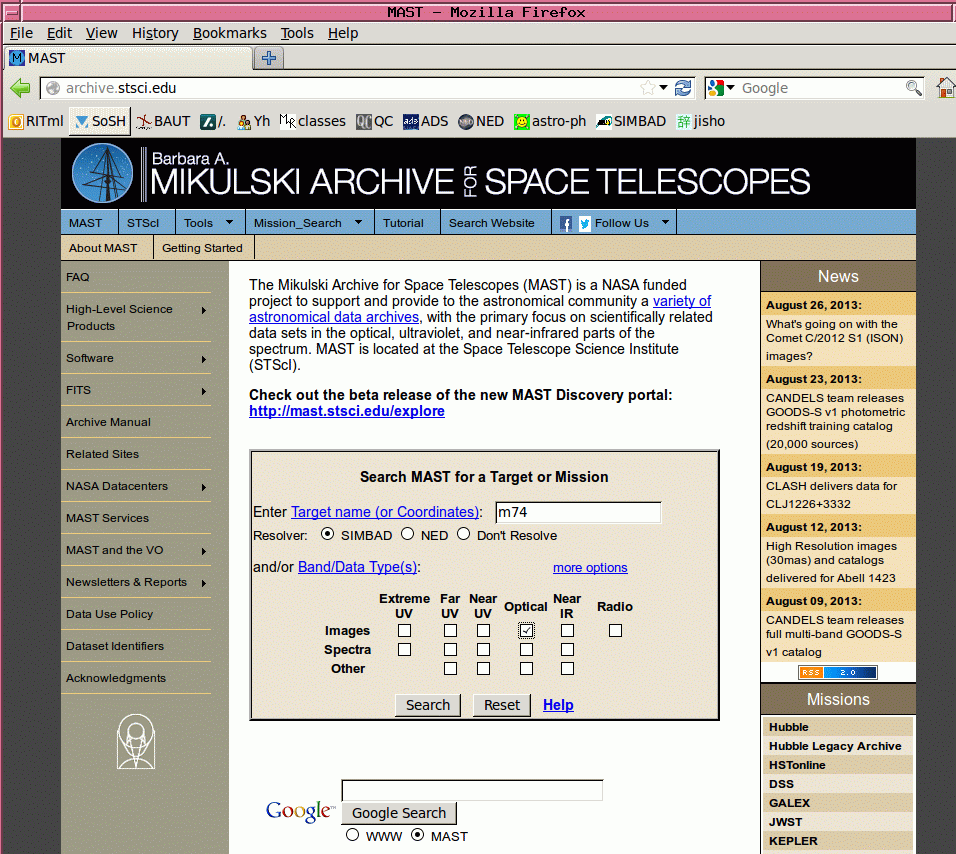
My search revealed that HST had indeed taken images of this galaxy; in fact, it had taken many images, with different instruments. I picked a set of images taken with the ACS (Advanced Camera for Surveys) in 2005. I combined several I-band images (j96r22rcq_drz and j96r22req_drz) in order to remove as many cosmic rays as possible. Now, we must remember that the field of view of HST is very small:
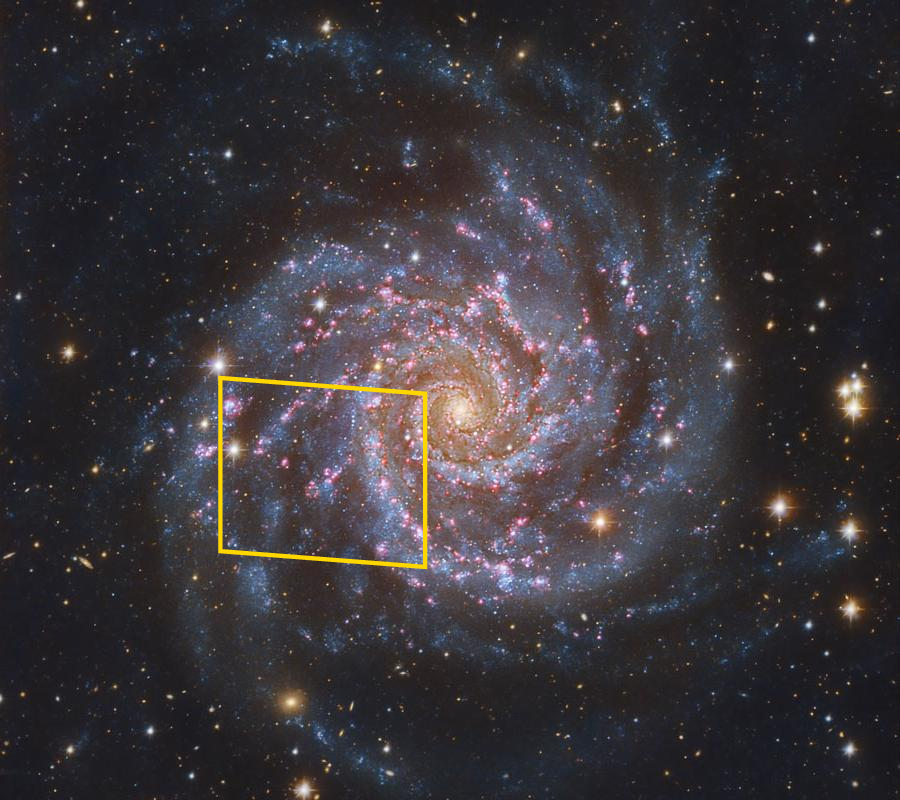
Here's a portion of the HST image of that region:
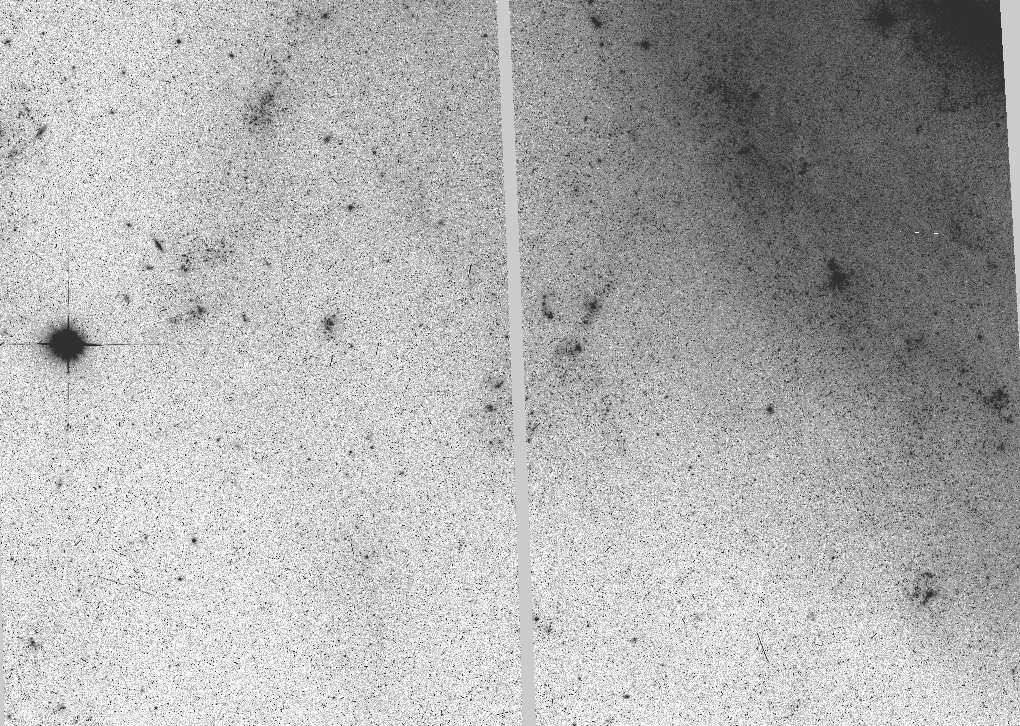
Using my (crummy) images as a reference, I was able to figure out that the SN should be roughly in the circled region of the image:
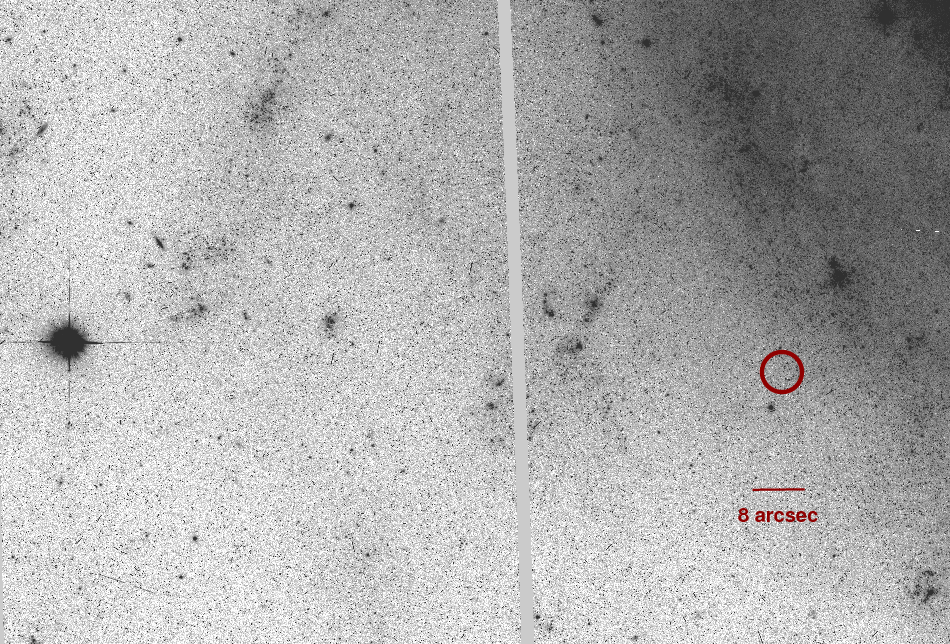
Let's zoom in a bit. Note that some of the cosmic rays are still visible at this scale.
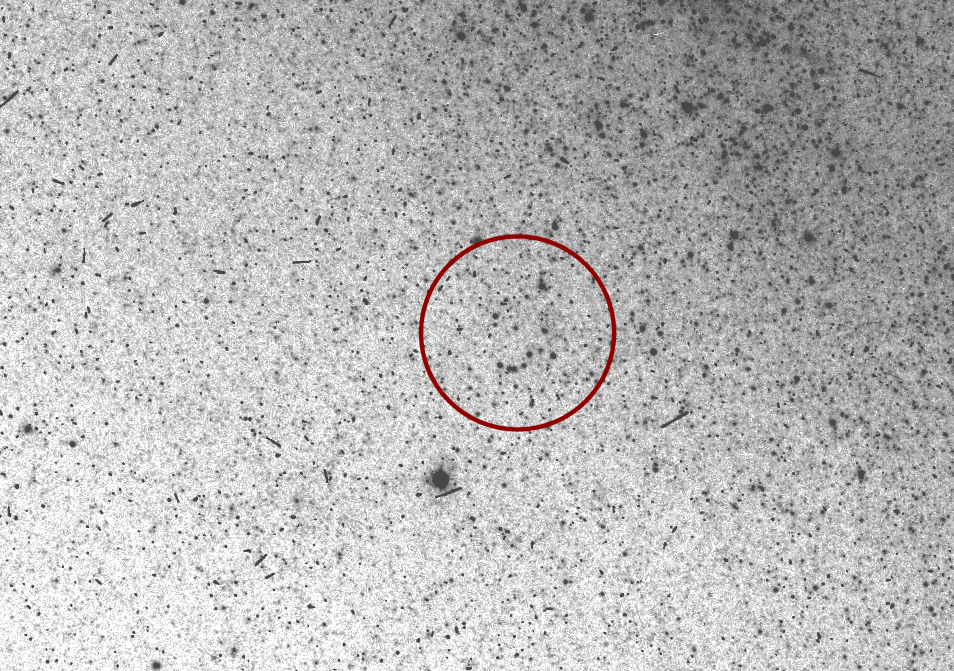
And zoom in even more.
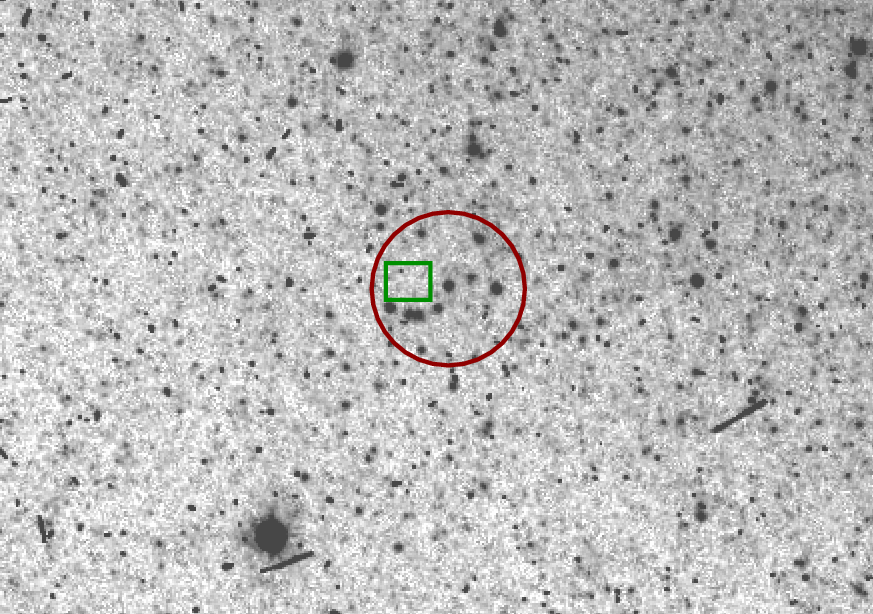
My best estimate for the position of the supernova, based on my images, was somewhere in the green box. I got about this far, then had to sleep. When I woke up the next day, I found out that I'd been too slow: at the Astronomer's Telegram website -- one of the best places to find fast-breaking astro-news -- a group of astronomers including the Berkeley team announced that they had identified the likely progenitor in several HST images. Their candidate lies at the center of the red circle in the images above.
Schuyler D. Van Dyk (IPAC/Caltech), Erik A. Petigura (UC Berkeley), S. Bradley Cenko (NASA/GSFC), WeiKang Zheng, Geoffrey W. Marcy (UC Berkeley), Andrew W. Howard (U. Hawaii/IfA), Ryan J. Foley (Harvard/Smithsonian CfA), Brad E. Tucker (ANU/UC Berkeley), Patrick L. Kelly, and Alexei V. Filippenko (UC Berkeley) report the identification of the probable progenitor of PSN J01364816+1545310 in archival Hubble Space Telescope (HST) Advanced Camera for Surveys/Wide Field Channel (WFC) images in bands F435W, F555W, and F814W from 2003 November and 2005 June.
That group measured apparent magnitudes of m(V) = 24.65 and m(I) = 22.61 , consistent with the expectations for a red supergiant in M74. However, they also measured an relatively bright value in B-band: m(B) = 25.03 . Here's a B-band image from HST:
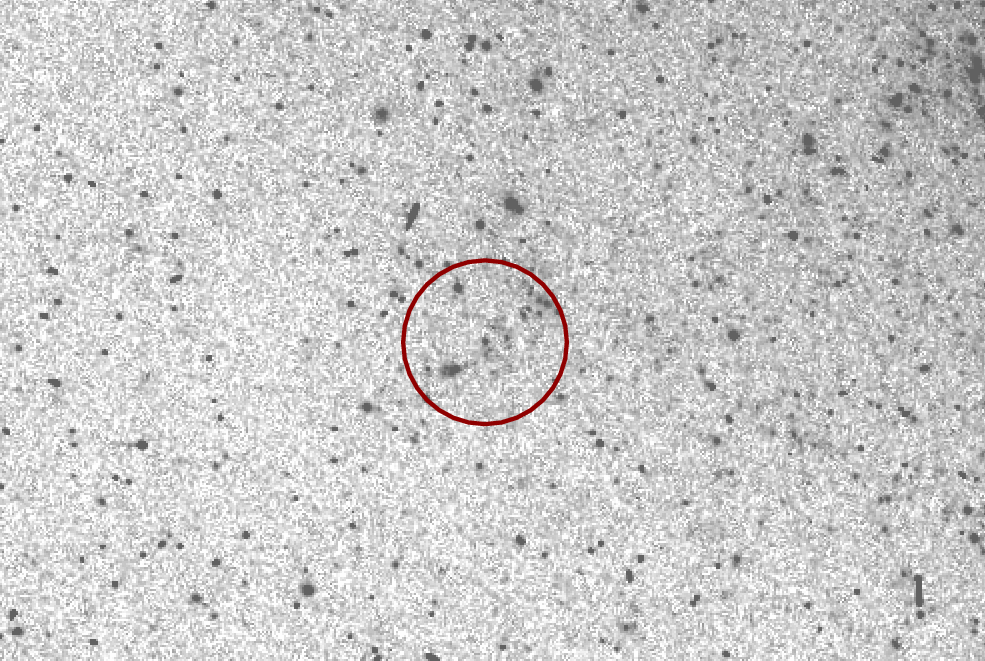
This is brighter than one would expect from a cool, red supergiant. Is it possible that the progenitor's light is mixed with that of a companion, or of a nearby cluster of stars?
The galaxy M74 is at a distance of roughly 9 Mpc = 9,000,000 pc. A single HST pixel is 0.05 arcseconds across = 2.4 x 10-7 radians. Q: How big an area in M74 does a single HST pixel cover?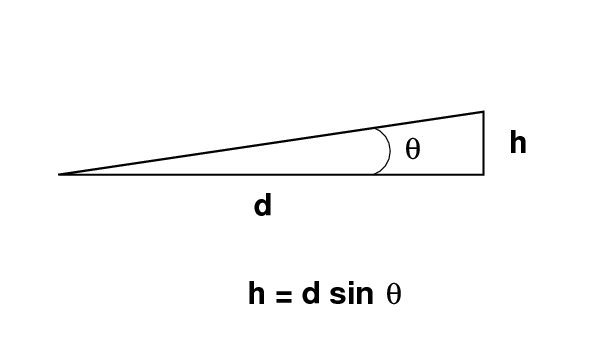
Since late July, I've been using the 12-inch telescope at the RIT Observatory to take images of SN 2013ej in M74 as frequently as I can. I usually take ten 30-second images in each of four filters, B, V, R, I. Some of the images have short trails or "jumps" due to errors in the mount's tracking, so I discard them. Here are examples of typical images in each filter. Please don't laugh. The order is B, V, R, I. Do you notice anything peculiar in one of the images?
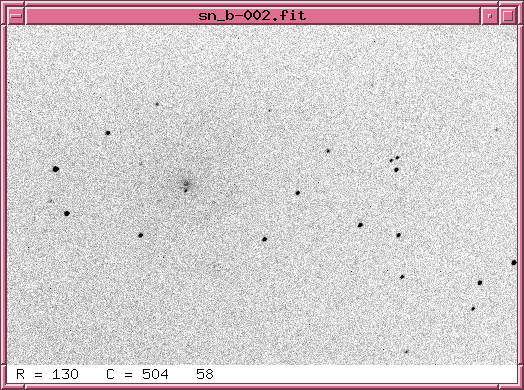
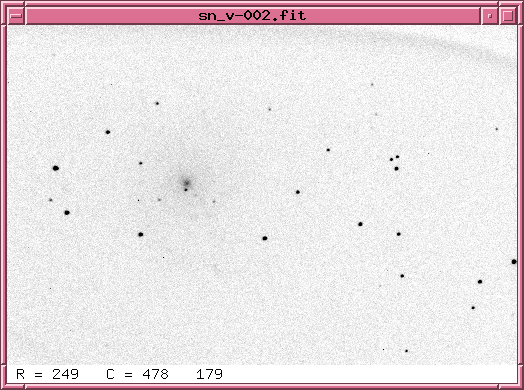
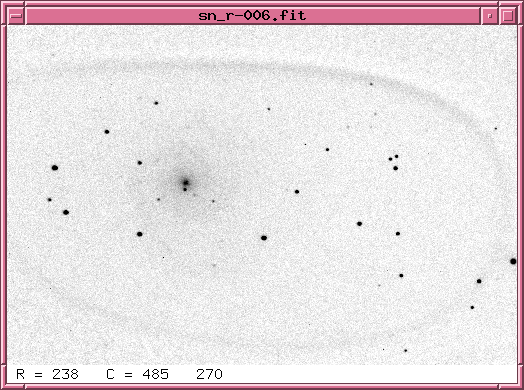
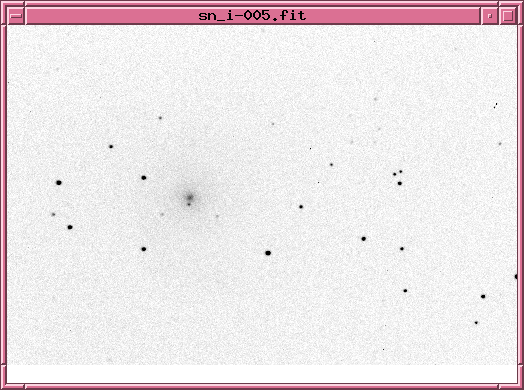
In each image, I measure the brightness of the supernova and several comparison stars (which are all members of our own Milky Way Galaxy). The American Association of Variable Star Observers provides carefully calibrated measurements of these comparison stars.
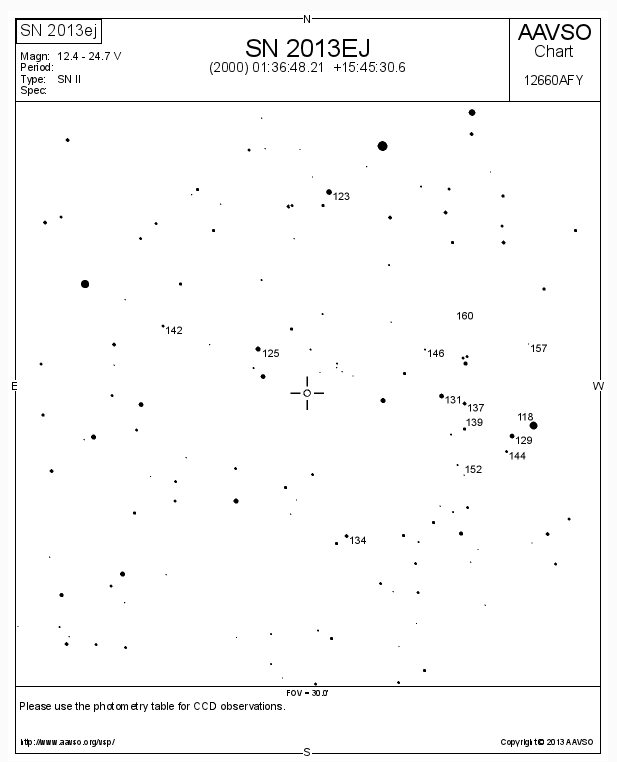
Using the AAVSO magnitudes of the comparison stars, I can convert my measured instrumental magnitudes onto the standard Johnson-Cousins scale.
So, what has happened since July 26?
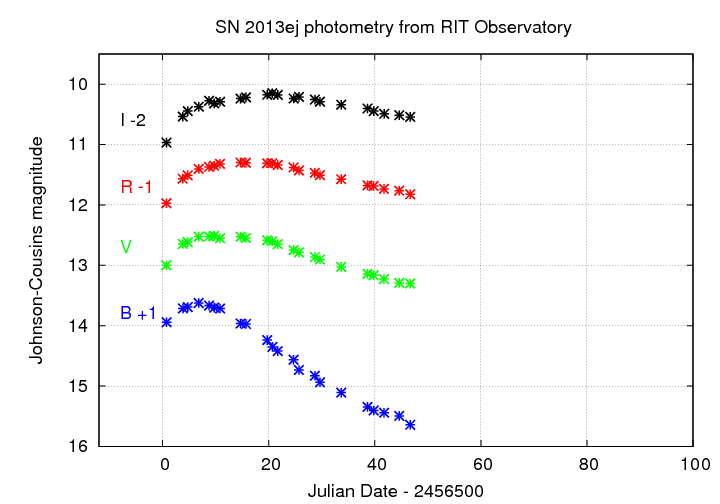
Remember the bright Type Ia SN 2011fe in M101? Let's take a look at our measurements of that supernova compared to the new one:
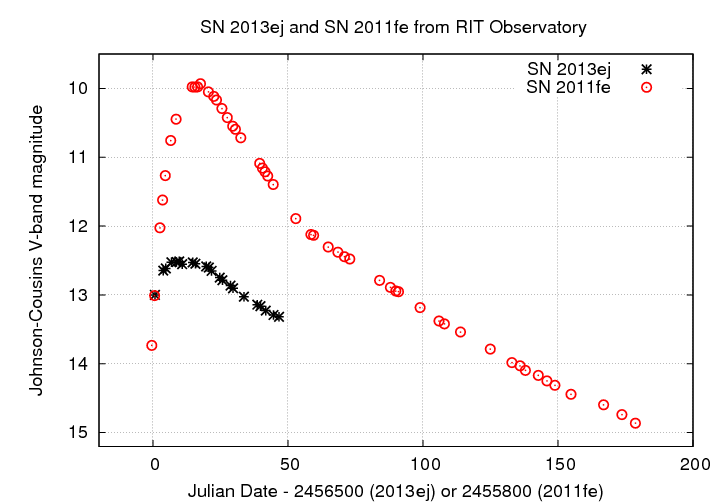
Q: Why does the new supernova 2013ej appear fainter?
 Copyright © Michael Richmond.
This work is licensed under a Creative Commons License.
Copyright © Michael Richmond.
This work is licensed under a Creative Commons License.